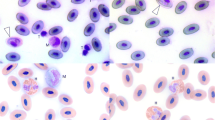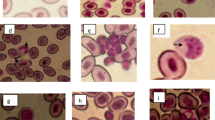Abstract
Hematology of free-living Indian rhacophorid tree frog, Polypedates maculatus, was studied. Sex wise variations in the hematological values, as well as significant correlation between size and different hematological parameters, were observed in this species.



Similar content being viewed by others
References
Alder A, Huber E (1923) Unstersucheng über blutcellen bei Amphibien und Reptilien. Folia Haematol 29:1–22
Arserim SK, Mermer A (2008) Hematology of the Uludağ frog, Rana macrocnemis Boulenger, 1885 in Uludağ National Park (Bursa, Turkey). E U J Fish Aquat Sci 25(1):39–46
Aruldose K, Indra N, Ramalingam R (2004) Toxicity of lead on haematological parameters of the male tree frog Polypedates maculatus (Gray). Indian J Envir Ecoplan 8(1):35–38
Arvy L (1947) Le dimorphisme Sexual sanquin chez Rana temporaria L. et Bufo vulgaris Compt. Rend Soc Biol 141:457–459
Atatür MK, Arikan H, Çevik IE (1999) Erythrocyte sizes of some anurans from Turkey. Tr J Zool 23:111–114
Cabagna MC, Lajmanovich RC, Stringhini G, Sanchez-Hernandez JC, Peltzer PM (2005) Hematological parameters of health status in the common toad Bufo arenarum in agrosystems of Santa Fe Province, Argentina. Appl Herpetol 2(4):373–380
Campbell TW (2004) Hematology of lower vertebrates. In: 55th annual meeting of the American College of Veterinary Pathologists (ACVP) and 39th annual meeting of the American Society of Clinical Pathology (ASVCP), ACVP and ASVCP (eds), pp 15–20
Carmena-Suero AS, Siret JP, Callejas J, Carmena DA (1980) Blood volume in male Hyla septentrionalis (tree frog) and Rana catesbeiana (bull frog). Comp Biochem Physiol 67(A):187–189
Cathers T, Lewbart GA, Correa M, Stevens JB (1997) Serum chemistry and hematology values for anesthetized American bullfrogs (Rana catesbeiana). J Zoo Wildl Med 28:171–174
Chiesa ME, Rosenberg CE, Fink NE, Salibian A (2006) Serum protein profile and blood cell counts in adult toads Bufo arenarum (Amphibia: Anura: Bufonidae): effects of sublethal lead acetate. Arch Environ Contaminat Toxicol 50:384–391
Coppo JA, Mussart NB, Fioranelli SA (2005) Blood and urine physiological values in farm-cultured Rana catesbieana (Anura: Ranidae) in Argentina. Rev Biol Trop 53(3–4):545–559
Cunningham WP, Saigo BW (1999) Environmental sciences: a global concern, 5th edn. WCB/McGraw-Hill, USA
Davis AK, Durso AM (2009) White blood cell differentials of Northern cricket frogs (Acris c. crepitans) with a compilation of published values from other amphibians. Hertetologica 65(3):260–267
Dickinson VM, Jarchow JL, Trueblood MH (2002) Hematology and plasma biochemistry reference range values for free-ranging desert tortoises in Arizona. J Wildl Dis 38(1):143–153
Dönmez F, Tosunoğlu M, Gül C (2009) Haematological values in hermaphrodite, Bufo bufo. N West J Zool 5(1):97–103
Garg AD, Hippargi RV (2007) Significance of frogs and toads in environmental conservation. In: Eco-environmental impact and organism response, NSEEIOR 2007, Nagpur, India, pp 80–85
Glomski CA, Tamburlin J, Hard R, Chainami M (1997) The phylogenetic odyssey of the erythrocyte. IV. The amphibians. Histol Histopathol 12:147–170
Gunther R (1977) Die Erythroytengrosse als kriterium Zur Unterscheidung diploider and triploider Teichfrosche. Rana esculenta L. (Anura). Biologisches Zentralbl 96(4):457–466
Hadji-Azimi I, Coosemans V, Canicatti C (1987) Atlas of adult Xenopus laevis laevis hematology. Dev Comp Immunol 11:807–874
Hartman FA, Lessler MA (1964) Erythrocyte measurements in fishes, amphibian, and reptiles. Biol Bull 126(1):83–88
Heatley JJ, Johnson M (2009) Clinical technique: amphibian hematology: a practitioner's guide. J Exotic Pet Med 18(1):14–18
Hutchison VH, Szarski H (1965) Number of erythrocytes in some amphibians and reptiles. Copeia 3:373–375
Indira N, Karpagaganapathy PR, Meenakhi V (1998) Haematological changes in Ale tree frog, Polypedates maculatus (Gray) under stress of phosphamidon. Indian J Environ Toxicol 8(2):90–91
Jacobson ER, Gaskin JM, Brown MB, Harris RK, Gardiner CH, Lapointe JL, Adams HP, Reggiardo C (1996) Chronic upper respiratory disease of free-ranging desert tortoises (Xerobates agassizii). J Wildl Dis 27:296–316
Kalpan HM (1951) A study of frog blood in red disease. Trans State Acad Sci 44:209–215
Kalpan HM (1952) Variations in white blood cells between normal and red leg frogs. Ibid 45:209–215
Kuramoto M (1981) Relationship between number, size and shape of red blood cells in amphibians. Comp Biochem Physiol 69(4):771–775
Maniero GD, Carey C (1997) Changes in selected aspects of immune function in the leopard frog, Rana pipiens, associated with exposure to cold. J Comp Physiol B 167:256–263
Ostojic H, Monge-C C, Cifuentes V (2000) Hemoglobin affinity for oxygen in three subspecies of toads (Bufo sp.) living at different altitudes. Biol Res (Santiago) 33(1):1–9
Ponsen S, Nerrkong NA, Pamok S, Sappaso K, Aengwanich W (2008) Hematological values and morphological observation of blood cells in balloon frog, Glyphogloossus molossus. J Micro Soc Thai 22:71–75
Raimon E, Ronci N, Ozzan M, Faryluk R, Borgogno P, González D, Suárez W (1996) Caracterización citológica y citométrica de elementos formes en sangre de Rana catesbeiana. Mongrafia. Biblioteca de la Facultad de Ciencias Exactas. UNAM, Posadas, p 10
Romanova EB, Romanova OY (2003) Peculiarities of leucocytic formula of peripheral blood of green frogs under conditions of anthropogenic load. J Evol Biochem Physiol 39:480–484
Rouf MA (1969) Haematology of the leopard frog, Rana pipiens. Copeia 4:682–687
Shutler D, Smith TG, Robinson SR (2009) Relationships between leucocytes and Hepatozon spp. in green frog, Rana clamitans. J Wildl Dis 45:67–72
Sinha RC (1983) Haematological studies on the prewintering and wintering frog, Rana esculenta. Comp Biochem Physiol 74(2):311–314
Szarski H, Czopek G (1966) Erythrocyte diameter in some amphibians and reptiles. Bull Acad Pol Sc Cl II Ser Sci Biol 14:437–443
Thompson RB (1969) A short text book of haematology. Pitman Medical and Scientific Publ. Co, London, pp 153–158
Tok CV, Tosunoğlu M, Ayaz D, ÇiÇek K, Gül C (2009) Haematology of the Lycian salamander, Lyciasalamandra fazilae. N West J Zool 5(2):321–329
Welsh HH Jr, Ollivier LM (1998) Stream amphibians as indicators of ecosystem stress: a case study from California's Redwoods. Ecol Appl 8(4):1118–1132
Wojtaszek J, Adamowicz A (2003) Haematology of the fire bellied toad Bombina bombina L. Comp Clin Pathol 12:129–134
Wright K (2001) Amphibian medicine and captive husbandry. In: Wright K, Whitaker B (eds) Amphibian medicine and captive husbandry. Kreiger Publishing, Malabar, pp 128–146
Zhelev ZM, Angelov MV, Mollov IA (2006) A study of some metric parameters of the erythrocytes in Rana ridibunda (Amphibia: Anura) derived from an area of highly developed chemical industry. Acta Zool Bulb 58(2):235–244
Acknowledgements
The authors would like to thank UGC for financial support (DRS II) to P.G. Department of Zoology, Utkal University. MD would like to thank UGC for a Research Fellowship (RFSMS). The authors would also like to thank the Head of P.G. Department of Zoology for providing necessary facilities.
Author information
Authors and Affiliations
Corresponding author
Rights and permissions
About this article
Cite this article
Mahapatra, B.B., Das, M., Dutta, S.K. et al. Hematology of Indian rhacophorid tree frog Polypedates maculatus Gray, 1833 (Anura: Rhacophoridae). Comp Clin Pathol 21, 453–460 (2012). https://doi.org/10.1007/s00580-010-1118-y
Received:
Accepted:
Published:
Issue Date:
DOI: https://doi.org/10.1007/s00580-010-1118-y




